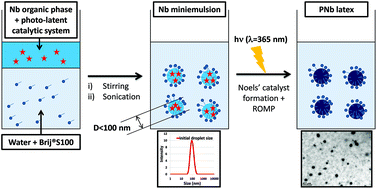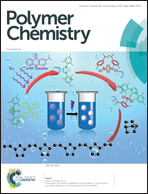Photolatent ring-opening metathesis polymerization in miniemulsion: a powerful approach to produce polynorbornene latexes†
Abstract
The use of miniemulsion Ring-Opening Metathesis Polymerization (ROMP) to form polyunsaturated latexes is still a largely unexplored field. The main obstacle remains the preparation of a chemically-stable monomer/catalyst miniemulsion, which is generally jeopardized by the high reactivity of ROMP catalysts at ambient temperature. To overcome this drawback, a photo-latent ROMP catalytic system has been employed for the first time. Our approach starts with an N-heterocyclic carbene (NHC) photogenerating system (1,3-bis(mesityl)imidazolium tetraphenylborate/2-isopropylthioxanthone) which enables the in situ formation of an active NHC-derived Ru catalyst. The ability to initiate the ROMP in miniemulsion by a photoactive route depends on the absorption conditions of the initial formulation due to irradiation attenuation by scattering. In this article, the optimization of an aqueous norbornene miniemulsion in order to improve the irradiation penetration depth is presented in the first part. In the second part, the miniemulsion ROMP is investigated by using the NHC photogenerating system and two ruthenium complex pre-catalyst [RuX2(p-cymene)] dimers (X = Cl or I). Stable PNb latexes with particle size in the range of 100 nm were obtained.



 Please wait while we load your content...
Please wait while we load your content...